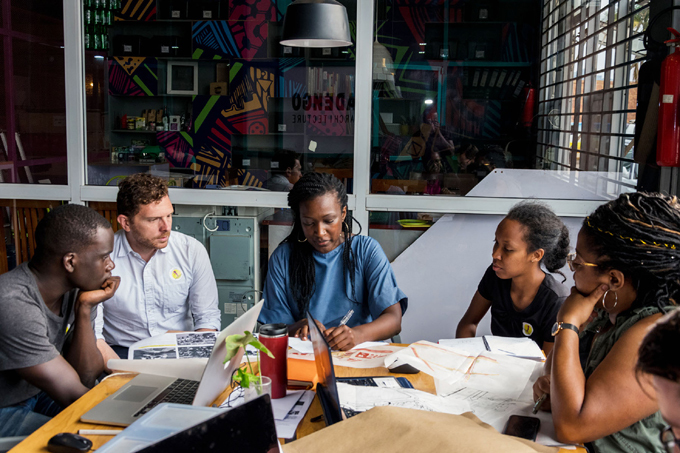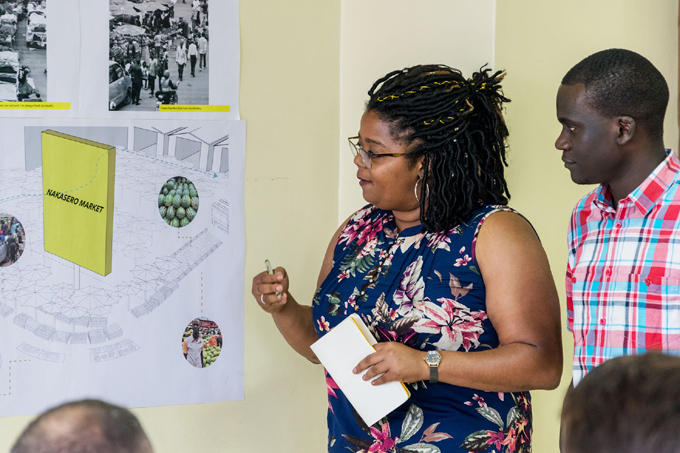Architects do a lot more than just buildings
In Uganda, architects have always been compared to engineers.
Uganda recently hosted students from the Sam Fox School of Design & Visual Arts at the Washington University in St. Louis. The visit was part of the university's Global Urbanism Studio project.
Jonathan Stitelman (JS), a visiting assistant professor at the Sam Fox School and Doreen Adengo (DA), the principal of Adengo Architecture and a facilitator of the Global Urbanism Studio - Kampala Workshop spoke to the New Vision's Samuel Sanya about the project and below is an excerpt of the conversation;
What is the global urbanisation studio project?
JS: This is my first year to be fully leading the Global Urbanism Studio but I have taught it for four years. At Washington University, this is part of the Master of Urban Design programme which is associated with the Architecture programme.
In our school, architecture split out from engineering in 1911. It is a different model from other schools which are under the umbrella of engineering. Just from an organisational perspective, at Washington University architecture and urban design sit outside of engineering; Urban design emerged out of architecture practice in the 1950s.
I am here with three graduate students who are doing their Masters Thesis semester. It is a privilege for our students to go into a foreign context, and recognise the potential and value of that place and translate that into a design proposal for the future condition. We look at places with extreme conditions; such as access to water, high population or building density, and different kinds of infrastructure and transportation that we can address through design.

Adengo (centre) and Stitelman training students of Sam Fox School of Design & Visual Arts at the Washington University in St. Louis and the Uganda Martyrs University
We were in Johannesburg, South Africa for one month before we travelled to Uganda. We luckily encountered Doreen who provided us space to look at the market dynamics of Kampala. We were looking at the dynamic and complex negotiations that emerge in the public realm through markets.
We looked at people at different hierarchies, different forms of labor, and it showed a great level of innovation that for an outsider was very interesting and inspiring. The aim of the workshop, from my perspective, has been to provide the students with a context that they are unfamiliar with and to use their abilities to show something that is pretty unique in Kampala.
DA: I will speak about the Global Urbanism Studio - Kampala workshop in the context of the role of the architect.
In Uganda, architects have always been compared to engineers. In addition to this, the word for an architect in Luganda is omukubi wa plan which means ‘person who draws the plan', but there is much more to what we do. In this context where the city is growing really fast and people are getting their own solutions, I thought it would be a good thing to select a market, such as Nakasero Market to see how people work and live.
We grouped students from the Uganda Martyrs University's Faculty for the Built Environment, with the students from Washington University; each group had one international student and two local students. To one student everything looked new while to the others, this is what they had grown up seeing, and they were wondering why we were even in the market.
The goal of the project was to understand how markets work so that when architects design new markets, they know what to include. There is vibrancy in Nakasero and there is a lot of money going through it. One of the students from Uganda Martyrs University is doing a thesis on the markets and they found that, in one of the new markets, vendors left their stalls and moved to their merchandise to the parking lot. It is important to find out why that happened.
How successful do you think the project has been?
JS: The workshop was about markets but we were given this one conceptual hinge, which Doreen made for us on the first day, which is a negotiation. Negotiation sometimes not visible, it can be a negotiation over the price of something or over the use of space. And so adaptation is certainly part of that. We were at the market from 6 am to 6 pm over a couple of days to understand how the market grows and shrinks and to understand how that is a byproduct of the negotiations.
What do you precisely mean by negotiation?
DA: The best way to understand it is from a non-architectural point of view. There is a negotiation for the price but also a negotiation for space. We found that there is a street corner where there is sometimes two lanes of traffic and one lane for selling. Then at certain times, the lanes of sellers increase into the road, in so doing they are negotiating on who is using that surface on the road. For example, during rush hour when traffic increases, the sellers move back from the road. So they are negotiating space.
JS: I think that that totally speaks to what architects do beyond the building. We are interested in the city as a whole. We are urban designers and architects. We have seen design fail and we are trying to establish certain critical spatial information that will inform future projects that will not destroy what is rich, interesting and valuable about existing markets. For us, our discipline requires that we must draw how we understand those negotiations.

Students of the two universities make a presentation
DA: For example, one of the student groups found a group of people that play Ludo in the market. When they were interviewed it turned out that they are the bag boys. The bag boys take groceries to restaurants or homes or some other stalls in the city. After their deliveries, they play Ludo. They negotiated with the people that run the market to play Ludo but not in an open place. What one student found is that a female vendor that sells banana leaves stacks them up in a way that shields the bag boys who are playing Ludo. They also found that the Ludo players go to a certain place to get tea before they play. So there are also women who serve tea in the market.
With all this, you start to realize that the market is not just made of stalls, but several social spaces. We have documented all these things so that whenever someone is designing a new market, they need to know that this is what makes the old market work.
The intangibles are the things you may not easily see immediately and you may not see on the plan but are a critical part of the market. The students also looked at the effect of shades; they found that if it is too hot, customers will stop to buy at places that have shade. And when it gets really hot, the amount of activity at the market drops. All these things should play into designing the market.
The teaching of architecture in Uganda is very different from the USA. How far behind are students in Uganda from their American counterparts?
JS: I recognize the expertise that the local students and architects have about this place. We are curious and interested to learn from the Uganda Martyrs University group. There are lots of surprises when you encounter new economies and new ways of transportation; for instance, there are no boda-bodas or mobile money in St. Louis Missouri. In this workshop, students used commonality in their training to draw together and to share ideas and observations about what surprised them. That was cool to see. I think that there is not too much different than I had initially anticipated. There is a lot of common ground and because of that, the students were able to cover so much ground and create powerful insights in a few days.
DA: I have taught in the USA and I have taught in Uganda, although I am not teaching at a University now. I find that the workshops are a way in which I am able to teach and still run a practice. What I have found is that there is actually no difference between the US and Ugandan students. Now with technology, an architecture student at Uganda Martyrs is not isolated; they can keep with the latest trends at whatever school around the world. I think a student in Uganda can do well in the USA.
The biggest difference though is resources. In the US, when you teach a design studio, you have one professor to 10 or 12 students, and when I was teaching at Uganda Martyrs, I was one professor to 23 students. There are other schools with a ratio of up to 60 students.
If a student is struggling, it is because there are not enough professors. If you put that same student in a context where the ratio is smaller, the student will do well.
JS: The students we have interacted with here would do well in a US institution. They are super bright and talented and have a clear view into a complex system and I have been impressed by them.